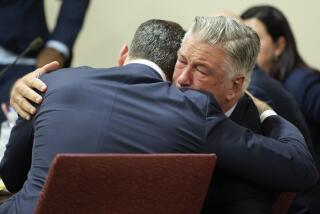Robert Durst murder trial is set for September

Four years after his arrest, Robert Durst — the idiosyncratic New York real estate tycoon accused of killing his best friend two decades ago — finally has a trial date.
During a court hearing in Los Angeles on Tuesday, a judge set the trial for late in the summer after conferring with Durst.
“Yeah,” Durst responded in his signature slow and creaking voice, “Sept. 3 is fine for trial.”
But in a setback for Durst’s defense team, the judge also ruled that the Los Angeles County district attorney’s office can present evidence in the trial relating to the 2001 killing of a Texas neighbor, for which Durst was acquitted of murder.
In the Los Angeles case, prosecutors contend that the 75-year-old, whose life was chronicled in an HBO miniseries, shot Susan Berman in the back of the head inside her Benedict Canyon home in 2000 to keep her from telling authorities what she knew about his wife’s disappearance in 1982.
A key prosecution claim is that Durst killed his first wife, Kathleen. Her body has never been recovered.
The multimillionaire has publicly denied involvement in Kathleen Durst’s disappearance and has pleaded not guilty in the Los Angeles case. His defense attorneys argue that the murder charge stemmed from publicity surrounding the HBO series, “The Jinx: The Life and Deaths of Robert Durst,” not from evidence.
Durst was arrested at a New Orleans hotel on March 14, 2015, in connection with Berman’s slaying. The next day, the finale of the six-part series aired and included a recording of Durst muttering, “Killed them all, of course,” during a bathroom break.
Some viewers considered the comment mumbled into a hot microphone as a confession to killing three people: Berman, his wife and his onetime neighbor in Galveston, Texas.
Durst fled to the small coastal town in Texas in the fall of 2000, days after articles about the reopening of an investigation into Kathleen Durst’s disappearance began appearing in New York newspapers, prosecutors said. He rented a $300-a-month apartment and disguised himself as an elderly, mute woman. Prosecutors have argued that only one person in Galveston — his neighbor, Morris Black — knew his true identity.
The real estate tycoon was charged with murdering Black, but claimed at his 2003 trial that a gun fired while he was defending himself during a tussle with his neighbor. Testifying in his own defense, Durst said, “The gun was aiming at me. He was pushing the gun towards me, and I was trying to pull the gun away,” according to court documents.
He fell to ground and the gun went off, Durst testified, adding that he didn’t go to the police because he didn’t think they would believe him. Durst admitted dismembering Black’s body and dumping the parts in Galveston Bay. Jurors acquitted him of murder.
In court Tuesday, Durst’s legal team sparred with prosecutors over what, if any, evidence from the Texas case should be presented to jurors in Los Angeles.
Chip Lewis, one of Durst’s attorneys, who also represented him during the 2003 trial, argued that bringing up old evidence would not only strip his client of a fair trial, but also undermine the decision of twelve jurors in Texas.
“What the people are attempting to do here is to, in fact, prosecute Mr. Durst for the exact same crime,” Lewis said. “The Constitution requires we respect returned verdicts of our sister states.”
Durst’s legal team expressed particular concern at the possibility of prosecutors showing jurors photographs of Black’s dismembered body parts, which were recovered from plastic bags found floating in Galveston Bay. The images are “unduly gruesome” and could “overcome the jury’s rationality,” attorneys wrote in a court filing.
Prosecutors said the evidence was crucial to their case in Los Angeles, arguing in a motion that the slayings of Black and Berman “are inextricably intertwined.” Both were killed, prosecutors allege, because they had incriminating information about Durst.
In court Tuesday, Deputy Dist. Atty. John Lewin turned to look at the defendant.
“That man beat a murder in Galveston,” Lewin said. “He got away with it.... He’s not going to get away a second time.”
Superior Court Judge Mark E. Windham ruled that prosecutors could use evidence from the Texas case at trial. In explaining his ruling, Windham said the killings of Black and Berman seemed “to be intertwined,” noting that both were killed while Durst was living on the lam.
“He changes his identity, he leaves town, and two people are killed,” the judge said.
Durst is scheduled to return to court for a pretrial hearing on May 14.
For more news from the Los Angeles County courts, follow me on Twitter: @marisagerber
More to Read
Sign up for Essential California
The most important California stories and recommendations in your inbox every morning.
You may occasionally receive promotional content from the Los Angeles Times.











